CompTIA A+ 220-1001 (Core 1)


About this course
The CompTIA A+ Core Series covers expanded content on growing parts of the IT support role including an expansion of baseline security topics and a different approach to defining competency in operational procedures. CompTIA A+ 220-1001 covers mobile devices, networking technology, hardware, virtualization and cloud computing, and network troubleshooting.
Course Outline
CompTIA A+ 220-1001 (Core 1)
1.0 – Mobile Devices
• What are we covering?
• 1.1 Given a scenario, install and configure laptop hardware and components
• 1.2 Given a scenario, install components within the display of a laptop
• 1.3 Given a scenario, use appropriate laptop features
• 1.4 Compare and contrast characteristics of various types of other mobiledevices
• 1.5 Given a scenario, connect and configure accessories and ports of other mobile devices
• 1.6 Given a scenario, configure basic mobile device network connectivity and application support
• 1.7 Given a scenario, use methods to perform mobile device synchronization
2.0 Networking
• What are we covering?
• 2.1 Compare and contrast TCP and UDP ports, protocols and their purpose
• 2.2 Compare and contrast common networking hardware devices
• 2.3 Given a scenario, install and configure a basic wired/wireless SOHO network
• 2.4 Compare and contrast wireless networking protocols
• 2.5 Summarize the properties and purposes of services provided by networked hosts
• 2.6 Explain common network configuration concepts
• 2.7 Compare and contrast internet connection types, network types and their
features
• 2.8 Given a scenario, use appropriate networking tools
3.0 Hardware
• What are we covering?
• 3.1 Explain basic cable types, features and their purposes
• 3.2 Identify common connector types
• 3.3 Given a scenario, install RAM types
• 3.4 Given a scenario, select, install and configure storage devices
• 3.5 Given a scenario, install and configure motherboards, CPUs and add-on cards
• 3.6 Explain the purposes and uses of various peripheral types
• 3.7 Summarize power supply types and features
• 3.8 Given a scenario, select and configure appropriate components for a custom PC configuration to meet customer specifications/needs
• 3.9 Given a scenario, install and configure common devices
• 3.10 Given a scenario, configure SOHO multifunction devices/printers and settings
• 3.11 Given a scenario, install and maintain various print technologies
4.0 Virtualization and Cloud Computing
• 4.1 Compare and contrast cloud computing concepts
• 4.2 Given a scenario, set up and configure client-side virtualization
5.0 Hardware and Network Troubleshooting
• What are we covering?
• 5.1 Given a scenario, use the best practice methodology to resolve problems
• 5.2 Given a scenario, troubleshoot problems related to motherboards, RAM, CPUs and power
• 5.3 Given a scenario, troubleshoot hard drives and RAID arrays
• 5.4 Given a scenario, troubleshoot video, projector and display issues
• 5.5 Given a scenario, troubleshoot common mobile device issues while adhering to the appropriate procedures
• 5.6 Given a scenario, troubleshoot printers
• 5.7 Given a scenario, troubleshoot common wires and wireless network problems
